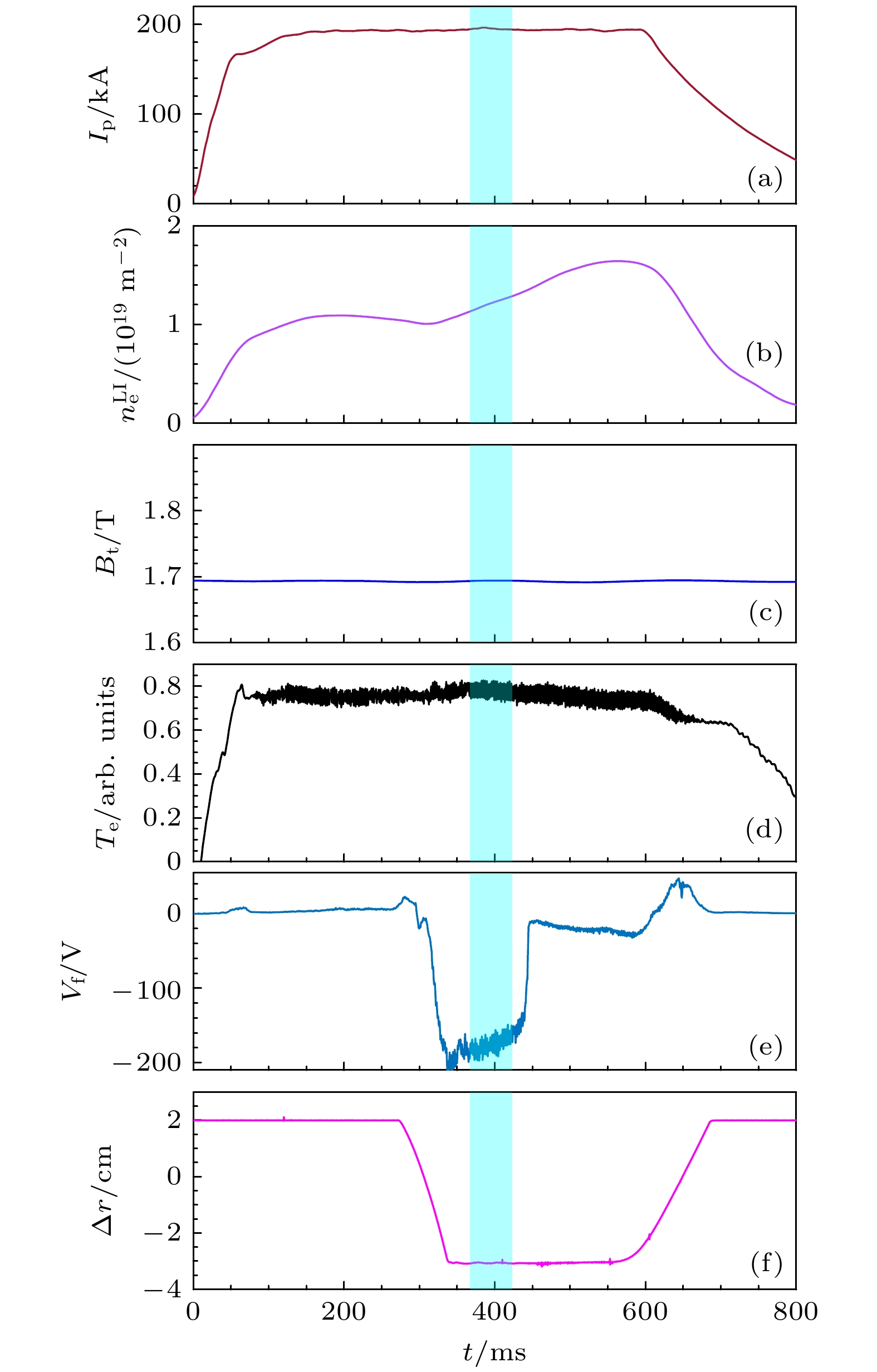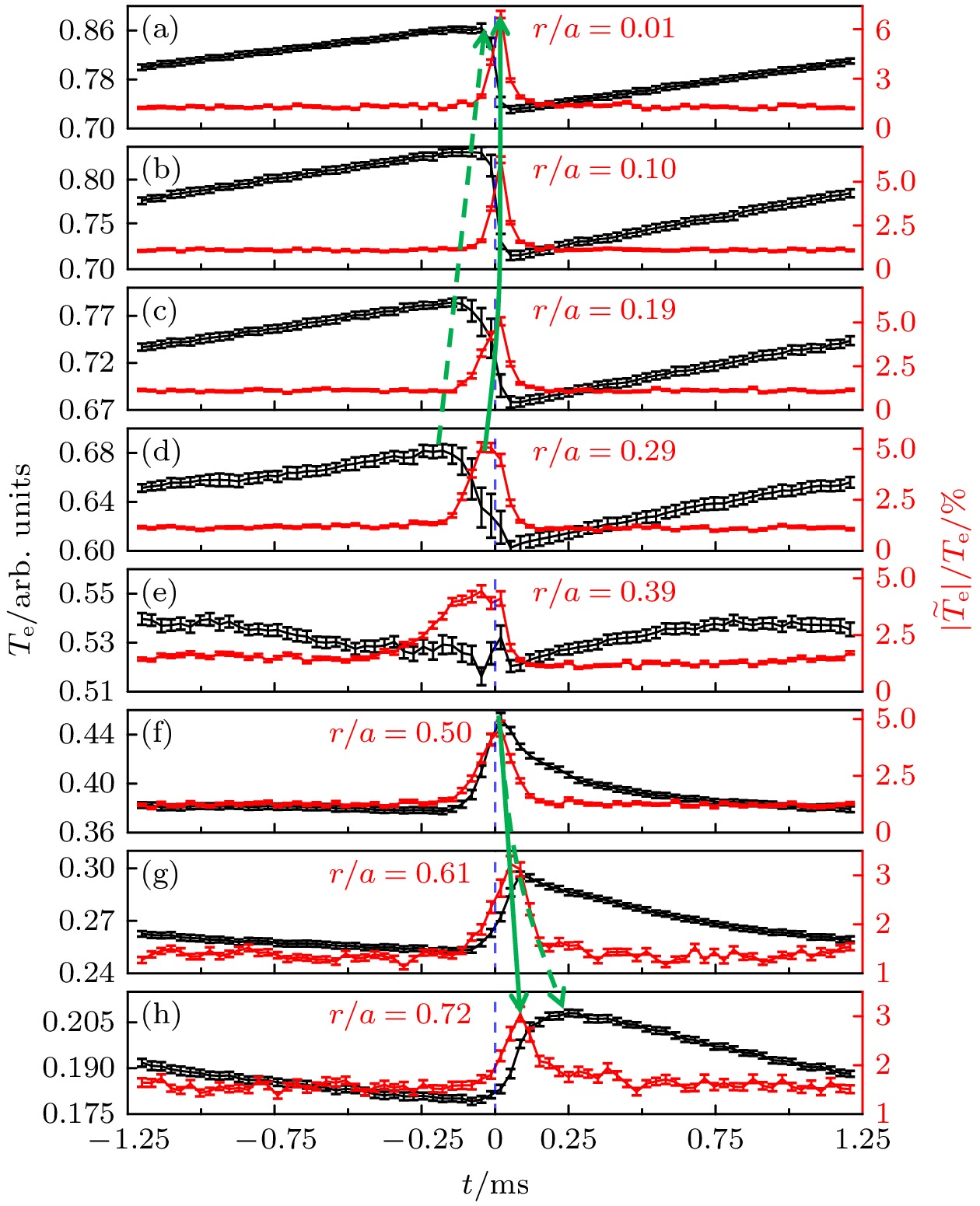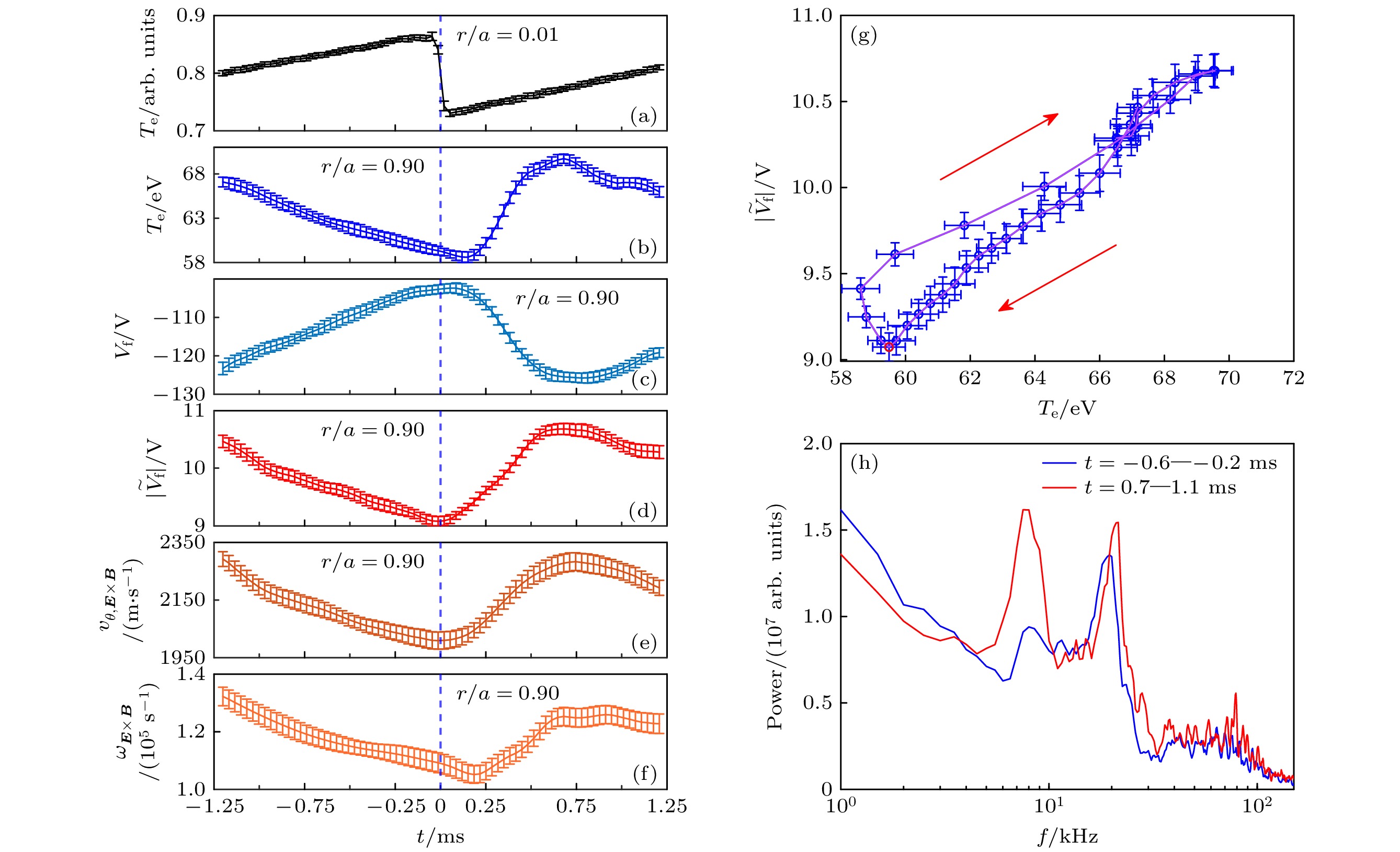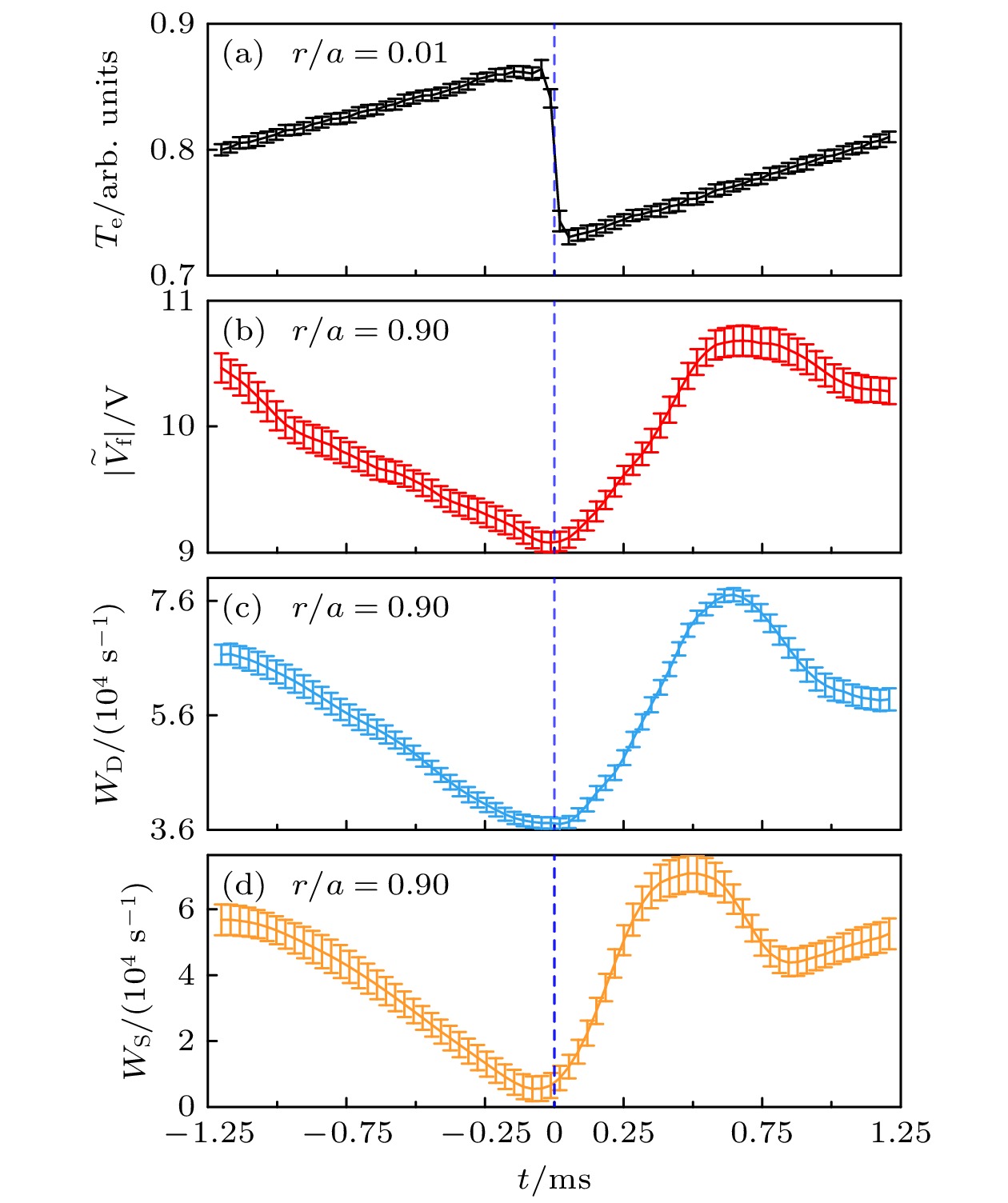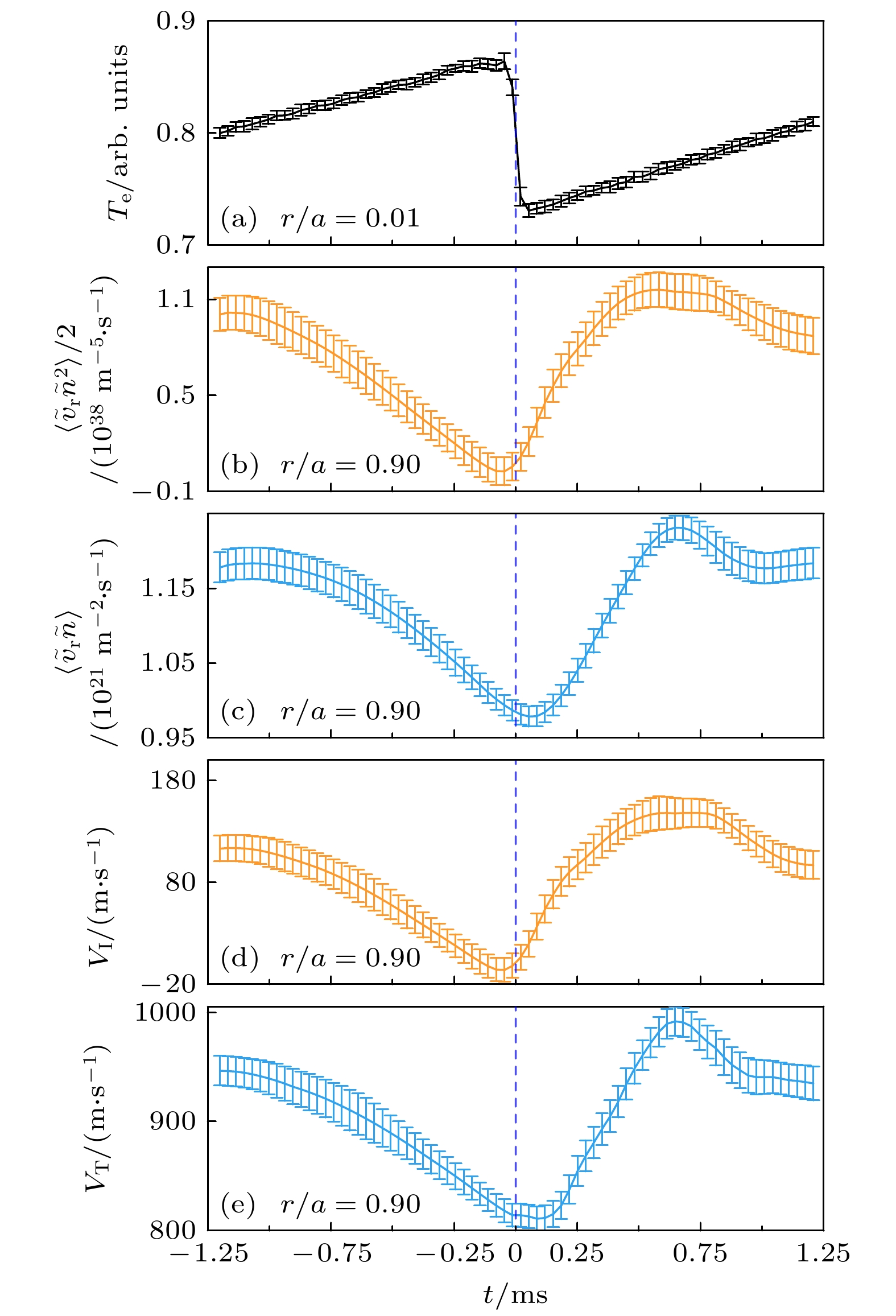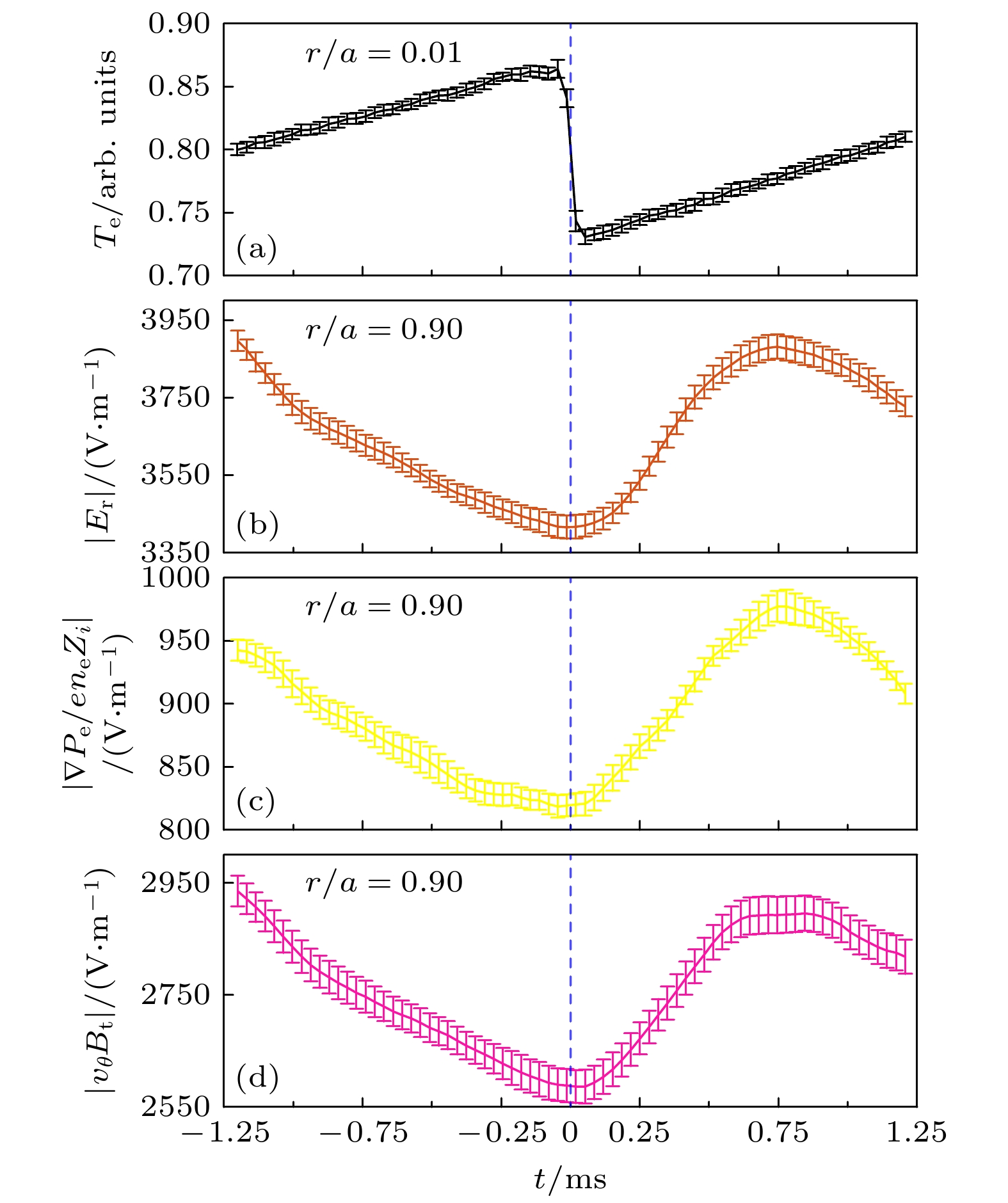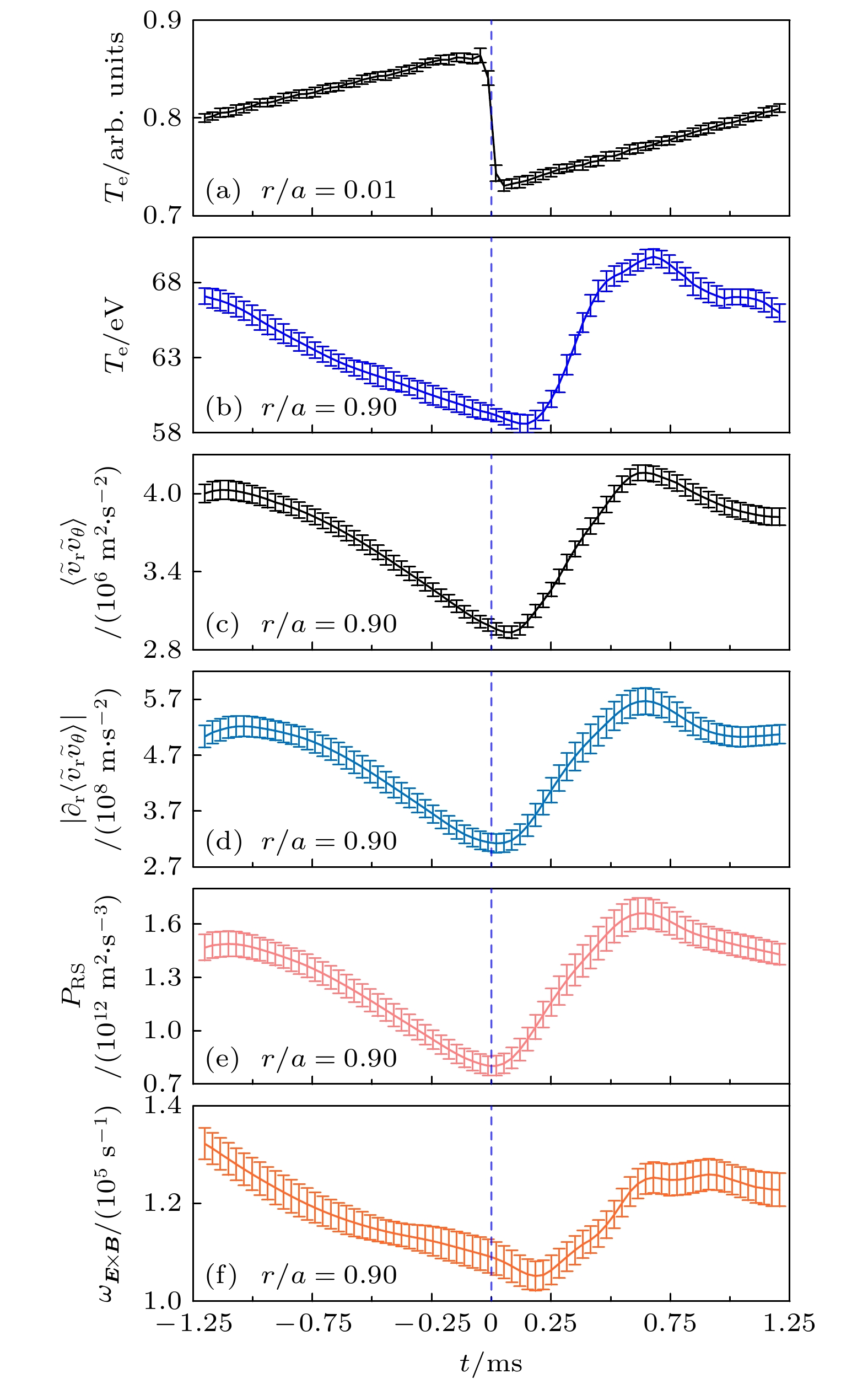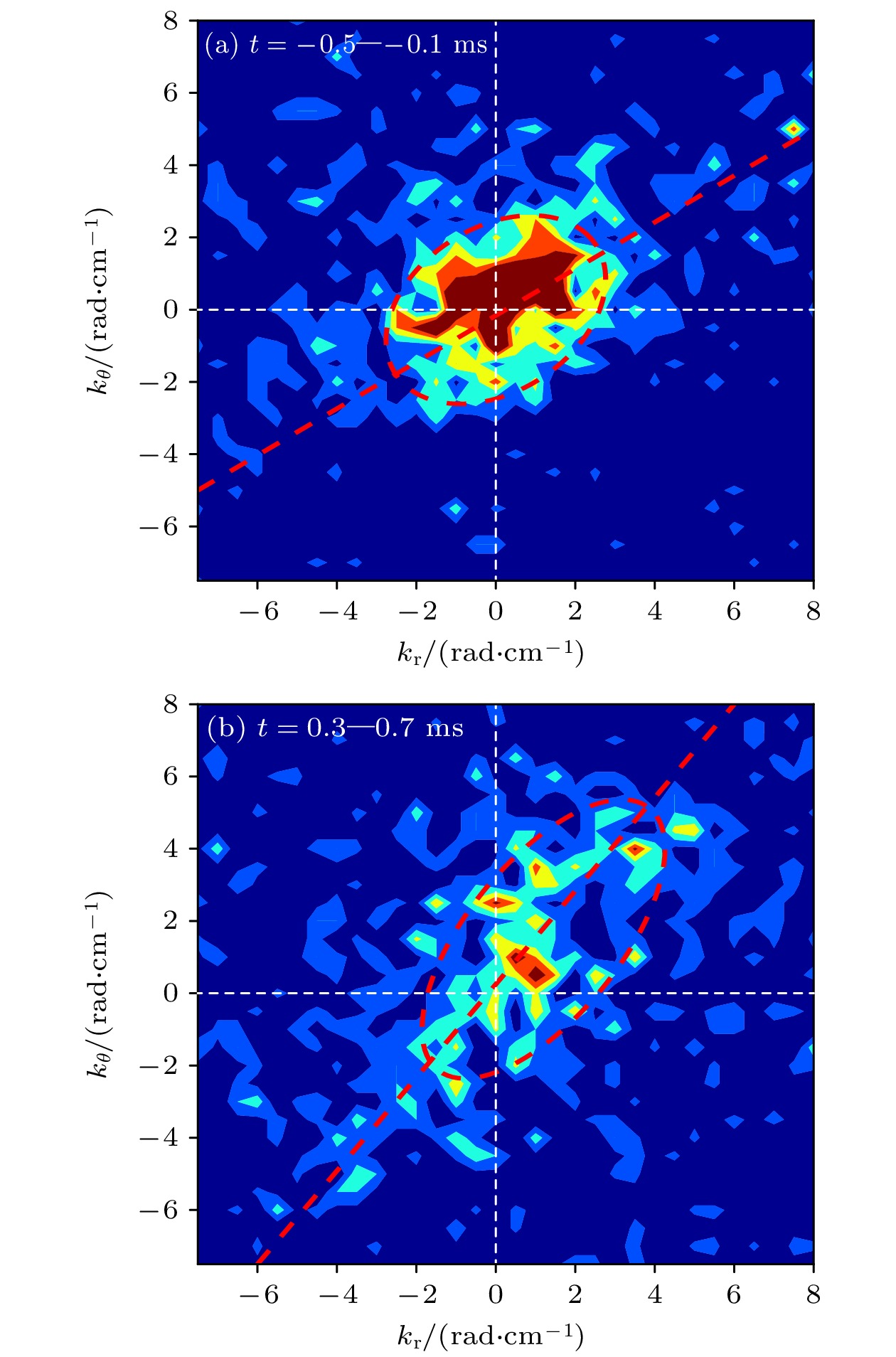-
The effect of sawteeth on plasma performance and transport in the plasma of tokamak is an important problem in the fusion field. Sawtooth oscillations can trigger off heat and turbulence pulses that propagate into the edge plasma, and thus enhancing the edge shear flow and inducing a transition from low confinement mode to high confinement mode. The influences of turbulence spreading and symmetry breaking on edge shear flow with sawtooth crashes are observed in the J-TEXT tokamak. The edge plasma turbulence and shear flow are measured using a fast reciprocating electrostatic probe array. The experimental data are analyzed using some methods such as conditional average and probability distribution function. After sawtooth crashes, the heat and turbulence pulses in the core propagate to the edge, with the turbulence pulse being faster than the heat pulse. The attached figures (a)–(e) show the core electron temperature, and the edge electron temperature, turbulence intensity, turbulence drive and spreading rates, Reynolds stress and its gradient, and shearing rates, respectively. After sawtooth crashes, the edge electron temperature increases and the edge turbulence is enhanced, with turbulence preceding temperature. The enhanced edge turbulence is mainly composed of two parts: the turbulence driven by local gradient and the turbulence spreading from core to edge. The development of the estimated turbulence spreading rate is prior to that of the turbulence driving rate. The increase in the turbulence intensity can cause the turbulent Reynold stress and its gradient to increase, thereby enhancing shear flows and radial electric fields. Turbulence spreading leads the edge Reynolds stresses to develop and the shear flow to be faster than edge electron temperature. The Reynolds stress arises from the symmetry breaking of the turbulence wave number spectrum. After sawtooth collapses, the joint probability density function of radial wave number and poloidal wave number of turbulence intensity becomes highly skewed and anisotropic, exhibiting strong asymmetry, which can be seen in attached figures (f) and (g). The development of turbulence spreading flux at the edge is also prior to the particle flux driven by turbulence, indicating that turbulent energy transport is not simply accompanied by turbulent particle transport. These results show that the turbulence spreading and symmetry breaking can enhance turbulent Reynolds stress, thereby driving shear flows, after sawtooth has crashed.
-
Keywords:
- tokamak /
- sawtooth /
- edge shear flow /
- Reynolds stress
[1] Hastie R J 1997 Astrophys. Space Sci. 256 177
 Google Scholar
Google Scholar
[2] Von Goeler S, Stodiek W, Sauthoff N 1974 Phys. Rev. Lett. 33 1201
 Google Scholar
Google Scholar
[3] Wanger F, Fussmann G, Grave T, Keilhacker M, Kornherr M, Lackner K, McCormick K, Müller E R, Stäbler A, Becker G, Bernhardi K, Ditte U, Eberhagen A, Gehre O, Gernhardt J, Gierke G V, Glock E, Gruber O, Haas G, Hesse M, Janeschitz G, Karger F, Kissel S, Klüber O, Lisitano G, Mayer H M, Meisel D, Mertens V, Murmann H, Poschenrieder W, Rapp H, Röhr H, Ryter F, Schneider F, Siller G, Smeulders P, Söldner F, Speth E, Steuer K H, Szymanski Z, Vollmer O 1984 Phys. Rev. Lett. 53 1453
 Google Scholar
Google Scholar
[4] Ido T, Kamiya K, Miura Y, Hamada Y, Nishizawa A, Kawasumi Y 2002 Phys. Rev. Lett. 88 055006
 Google Scholar
Google Scholar
[5] Martin Y R, Team TCV 2004 Plasma Phys. Controlled Fusion 46 A77
 Google Scholar
Google Scholar
[6] Moyer R A, Burrell K H, Carlstrom T N, Coda S, Conn R W, Doyle E J, Gohil P, Groebner R J, Kim J, Lehmer R, Peebles W A, Porkolab M, Rettig C L, Rhodes T L, Seraydarian R P, Stockdale R, Thomas D M, Tynan G R, Watkins J G 1995 Phys. Plasmas 2 2397
 Google Scholar
Google Scholar
[7] Burrell K H 1997 Phys. Plasmas 4 1499
 Google Scholar
Google Scholar
[8] Manz P, Xu M, Thakur S C, Tynan G R 2011 Plasma Phys. Controlled Fusion 53 095001
 Google Scholar
Google Scholar
[9] Zhao K J, Cheng J, Diamond P H, Dong J Q, Yan L W, Hong W Y, Xu M, Tynan G, Miki K, Huang Z H, Itoh K, Itoh S I, Fujisawa A, Nagashima Y, Inagaki S, Wang Z X, Wei L, Song X M, Lei G J, Li Q, Ji X Q, Liu Y, Yang Q W, Ding X T, Duan X R, HL-2A Team 2013 Nucl. Fusion 53 123015
 Google Scholar
Google Scholar
[10] Zhao K J, Nagashima Y, Guo Z B, Dong J Q, Yan L W, Itoh K, Itoh S I, Li X B, Li J Q, Fujisawa A, Inagaki S, Cheng J, Xu J Q, Kosuga Y, Sasaki M, Wang Z X, Zhang H Q, Chen Y Q, Cao X G, Yu D L, Liu Y, Song X M, Xia F, Wang S 2022 Plasma Sci. Technol. 25 015101
 Google Scholar
Google Scholar
[11] Zhang J Y, Zhao K J, Yang Z J, Chen Z P, Guo Z B, Dong J Q, Itoh K, Chen Z Y, Shi Y J, Ding Y H, Li J Q, Xie Y Y, Zhang H Q, Chen Y Q, Li R, Cao X G, Du J J, Jiang J M, Zhang G S, Cheng J, Xu J Q, Xiang L, Wang N C, Wang L, Liang Y F, J-TEXT team 2023 Phys. Plasmas 30 082305
 Google Scholar
Google Scholar
[12] Grenfell G, Van Milligen B PH, Losada U, Ting W, Liu B, Silva C, Spolaore M, Hidalgo C, TJ-II Team 2019 Nucl. Fusion 59 016018
 Google Scholar
Google Scholar
[13] Long T, Diamond P H, Ke R, Chen Z P, Xu X, Tian W J, Hong R J, Cao M Y, Liu Y M, Xu M, Wang L, Yang Z J, Yuan J B, Zhou Y K, Yan Q H, Yang Q H, Shen C S, Nie L, Wang Z H, Hao G Z, Wang N C, Chen Z Y, Li J Q, Chen Wei, Zhong W L 2024 Nucl. Fusion 64 066011
 Google Scholar
Google Scholar
[14] Long T, Diamond P H, Ke R, Chen Z P, Cao M Y, Xu X, Xu M, Hong R J, Tian W J, Yuan J B, Liu Y M, Yan Q H, Yang Q H, Shen C S, Guo W X, Wang L, Nie L, Wang Z H, Hao G Z, Wang N C, Chen Z Y, Pan Y, Li J Q, Chen W, Zhong W L 2024 Nucl. Fusion 64 064002
 Google Scholar
Google Scholar
[15] Ding Y H, Wang N C, Chen Z Y, Xia D H, Yang Z J, Chen Z P, Zheng W, Yan W, Li D, Zhou S, Xu X, Zhang X Y, Mao F Y, Fang J G, Ren Z K, Chen X X, Zhang J L, Zhang X B, He Y, Zhang Q, Li Y, Bai W, Mou L K, Li F, Long T, Ke R, Gao L, Shi P, Shen C S, Liu J X, Guo W X, Wang L, Li H H, Jiang Z H, Zhang X Q, Li J C, Rao B, Cheng Z F, Zhu P, Liu M H, Xu T, Ma S X, Yang Y, Li C, Wang Z J, Zhang M, Yu K X, Hu X W, Liang Y, Yu Q, Gentle K W, Pan Y, the J-TEXT Team 2024 Nucl. Fusion 64 112005
 Google Scholar
Google Scholar
[16] Liang Y F, Wang N C, Ding Y H, Chen Z Y, Chen Z P, Yang Z J, Hu Q M, Cheng Z F, Wang L, Jiang Z H, Rao B, Huang Z, Li Y, Yan W, Li D, Liu H, Zeng L, Huang Y, Huang D W, Lin Z F, Zheng W, Hu F R, Zhao K J, Jiang M, Shi Y J, Zhou H, Peng S T, Guo W X, Gao L, Wang Z J, Zhang M, Yu K X, Hu X W, Yu Q, Zhuang G, Gentle K W, Pan Y, the J-TEXT Team 2019 Nucl. Fusion 59 112016
 Google Scholar
Google Scholar
[17] Zhao K J, Lan T, Dong J Q, Yan L W, Hong W Y, Yu C X, Liu A D, Qian J, Cheng J, Yu D L, Yang Q W, Ding X T, Liu Y, Pan C H 2006 Phys. Rev. Lett. 96 255004
 Google Scholar
Google Scholar
[18] Xie Y Y, Zhao K J, Yang Z J, Chen Z P, Dong J Q, Chen Z Y, Shi Y J, Tan M Z, Gao L, Ding Y H, Chen Y Q, Zhang H Q, Li R, Cao X G, Du J J, Jiang J M, Zhang G S, Cheng J, Xu J Q, Zhang J Y, Xiang L, Wang N C, Wang L, Liang Y F 2025 Plasma Phys. Controlled Fusion 67 015008
 Google Scholar
Google Scholar
[19] Manz P, Ribeiro T T, Scott B D, Birkenmeier G, Carralero D, Fuchert G, Müller S H, Müller H W, Stroth U, Wolfrum E 2015 Phys. Plasmas 22 022308
 Google Scholar
Google Scholar
[20] Wu T, Diamond P H, Nie L, Xu M, Yu Y, Hong R J, Chen Y H, Xu J Q, Long T, Zhang Y, Yan Q H, Ke R, Cheng J, Li W, Huang Z H, Yan L W, Chu X, Wang Z H, Hidalgo C 2023 Nucl. Fusion 63 126001
 Google Scholar
Google Scholar
[21] Long T, Diamond P H, Ke R, Nie L, Xu M, Zhang X Y, Li B L, Chen Z P, Xu X, Wang Z H, Wu T, Tian W J, Yuan J B , Yuan B D, Gong S B, Xiao C Y, Gao J M, Hao Z G, Wang N C, Chen Z Y, Yang Z J, Gao L, Ding Y H, Pan Y, Chen W, Hao G Z, Li J Q, Zhong W L, Duan X R 2021 Nucl. Fusion 61 126066
 Google Scholar
Google Scholar
[22] Gürcan Ö D, Diamond P H, Hahm T S 2006 Phys. Plasmas 13 052306
 Google Scholar
Google Scholar
[23] Hahm T S, Diamond P H 2018 J. Korean Phys. Soc. 73 747
 Google Scholar
Google Scholar
[24] Wolf R C 2003 Plasma Phys. Controlled Fusion 45 R1
 Google Scholar
Google Scholar
[25] Zhao K J, Chen Z P, Shi Y J, Diamond P H, Dong J Q, Chen Z Y, Ding Y H, Zhuang G, Liu Y B, Zhang H Q, Chen Y Q, Liu H, Cheng J, Nie L, Rao B, Cheng Z F, Gao L, Zhang X Q, Yang Z J, Wang N C, Wang L, Li J Q, Jin W, Xu J Q, Yan L W, Liang Y F, Xie Y Y, Liu B 2020 Nucl. Fusion 60 106030
 Google Scholar
Google Scholar
[26] Diamond P H, Kim Y B 1991 Phys. Fluids B 3 1621
 Google Scholar
Google Scholar
[27] Xu Y H, Yu C X, Luo J R, Mao J S, Liu B H, Li J G, Wan B N, Wan Y X 2000 Phys. Rev. Lett. 84 3867
 Google Scholar
Google Scholar
[28] Diamond P H, Kosuga Y, Gürcan Ö D, McDevitt C J, Hahm T S, Fedorczak N, Rice J E, Wang W X, Ku S, Kwon J M, Dif-Pradalier G, Abiteboul J, Wang L, Ko W H, Shi Y J , Ida K, Solomon W, Jhang H, Kim S S, Yi S, Ko S H, Sarazin Y, Singh R, Chang C S 2013 Nucl. Fusion 53 104019
 Google Scholar
Google Scholar
-
图 2 等离子体放电参数 (a)等离子体电流; (b)线积分电子密度; (c)环向磁场; (d) $ r/a=0.01 $处的电子温度; (e) $ r/a=0.88 $处的悬浮电位; (f)探针位移
Fig. 2. Plasma discharge parameters: (a) Plasma current; (b) line integrated electron density; (c) toroidal magnetic field; (d) electron temperature at $ r/a=0.01 $; (e) floating potential at $ r/a=0.88 $; (f) probe positions.
图 4 (a) $ r/a=0.01 $处的电子温度; (b) $ r/a=0.90 $处的电子温度; (c) $ r/a=0.90 $处的悬浮电位; (d) $ r/a=0.90 $处的湍流强度; (e) $ r/a=0.90 $处的$ \boldsymbol{E}\times \boldsymbol{B} $极向速度; (f) $ r/a=0.90 $处的剪切率; (g) $ r/a=0.90 $处的电子温度和湍流强度的李萨如图; (h) $ r/a=0.90 $处锯齿崩塌前后悬浮电位的自功率谱
Fig. 4. (a) Electron temperature at $ r/a=0.01 $; (b) electron temperature at $ r/a=0.90 $; (c) floating potential at $ r/a=0.90 $; (d) turbulence intensity at $ r/a=0.90 $; (e) $ \boldsymbol{E}\times \boldsymbol{B} $ poloidal velocity at $ r/a=0.90 $; (f) shearing rate at $ r/a=0.90 $; (g) trajectory of electron temperature and turbulence intensity at $ r/a=0.90; $ (h) auto-power spectra of the floating potential before and after sawtooth collapse at $ r/a=0.90 $.
图 6 (a) $ r/a=0.01 $的电子温度; (b) $ r/a=0.90 $处的湍流传播通量; (c) $ r/a=0.90 $处的湍流粒子通量; (d) $ r/a= $$ 0.90 $处的湍流传播平均射流速度; (e) $ r/a=0.90 $处的粒子输运速度
Fig. 6. (a) Electron temperature at $ r/a=0.01 $; (b) turbulence spreading flux at $ r/a=0.90 $; (c) turbulence particle flux at $ r/a=0.90 $; (d) mean jet velocity of turbulence spreading at $ r/a=0.90; $ (e) particle transport velocity at $ r/a=0.90 $.
图 7 (a) $ r/a=0.01 $处的电子温度; $ ({\mathrm{b}})\;r/a=0.90 $处的径向电场强度; (c) $ r/a=0.90 $处的压强梯度; (d) $ r/a=0.90 $处的极向流对径向电场的贡献
Fig. 7. (a) Electron temperature at $ r/a=0.01 $; (b) radial electric fields intensity at $ r/a=0.90 $; (c) contributions of the pressure gradient at $ r/a=0.90; $ (d) poloidal flows to the radial electric field at $ r/a=0.90 $.
图 8 (a) $ r/a=0.01 $处的电子温度; (b) $ r/a=0.90 $处的电子温度; (c) $ r/a=0.90 $处的雷诺协强; (d) $ r/a=0.90 $处的雷诺协强梯度; (e) $ r/a=0.90 $处的雷诺功; (f) $ r/a=0.90 $处的剪切率
Fig. 8. (a) Electron temperature at $ r/a=0.01 $; (b) electron temperature at $ r/a=0.90 $, (c) Reynolds stress at $ r/a=0.90 $; (d) gradient of Reynolds stress at $ r/a=0.90 $; (e) Reynolds power at $ r/a=0.90; $ (f) shearing rate at $ r/a=0.90 $.
-
[1] Hastie R J 1997 Astrophys. Space Sci. 256 177
 Google Scholar
Google Scholar
[2] Von Goeler S, Stodiek W, Sauthoff N 1974 Phys. Rev. Lett. 33 1201
 Google Scholar
Google Scholar
[3] Wanger F, Fussmann G, Grave T, Keilhacker M, Kornherr M, Lackner K, McCormick K, Müller E R, Stäbler A, Becker G, Bernhardi K, Ditte U, Eberhagen A, Gehre O, Gernhardt J, Gierke G V, Glock E, Gruber O, Haas G, Hesse M, Janeschitz G, Karger F, Kissel S, Klüber O, Lisitano G, Mayer H M, Meisel D, Mertens V, Murmann H, Poschenrieder W, Rapp H, Röhr H, Ryter F, Schneider F, Siller G, Smeulders P, Söldner F, Speth E, Steuer K H, Szymanski Z, Vollmer O 1984 Phys. Rev. Lett. 53 1453
 Google Scholar
Google Scholar
[4] Ido T, Kamiya K, Miura Y, Hamada Y, Nishizawa A, Kawasumi Y 2002 Phys. Rev. Lett. 88 055006
 Google Scholar
Google Scholar
[5] Martin Y R, Team TCV 2004 Plasma Phys. Controlled Fusion 46 A77
 Google Scholar
Google Scholar
[6] Moyer R A, Burrell K H, Carlstrom T N, Coda S, Conn R W, Doyle E J, Gohil P, Groebner R J, Kim J, Lehmer R, Peebles W A, Porkolab M, Rettig C L, Rhodes T L, Seraydarian R P, Stockdale R, Thomas D M, Tynan G R, Watkins J G 1995 Phys. Plasmas 2 2397
 Google Scholar
Google Scholar
[7] Burrell K H 1997 Phys. Plasmas 4 1499
 Google Scholar
Google Scholar
[8] Manz P, Xu M, Thakur S C, Tynan G R 2011 Plasma Phys. Controlled Fusion 53 095001
 Google Scholar
Google Scholar
[9] Zhao K J, Cheng J, Diamond P H, Dong J Q, Yan L W, Hong W Y, Xu M, Tynan G, Miki K, Huang Z H, Itoh K, Itoh S I, Fujisawa A, Nagashima Y, Inagaki S, Wang Z X, Wei L, Song X M, Lei G J, Li Q, Ji X Q, Liu Y, Yang Q W, Ding X T, Duan X R, HL-2A Team 2013 Nucl. Fusion 53 123015
 Google Scholar
Google Scholar
[10] Zhao K J, Nagashima Y, Guo Z B, Dong J Q, Yan L W, Itoh K, Itoh S I, Li X B, Li J Q, Fujisawa A, Inagaki S, Cheng J, Xu J Q, Kosuga Y, Sasaki M, Wang Z X, Zhang H Q, Chen Y Q, Cao X G, Yu D L, Liu Y, Song X M, Xia F, Wang S 2022 Plasma Sci. Technol. 25 015101
 Google Scholar
Google Scholar
[11] Zhang J Y, Zhao K J, Yang Z J, Chen Z P, Guo Z B, Dong J Q, Itoh K, Chen Z Y, Shi Y J, Ding Y H, Li J Q, Xie Y Y, Zhang H Q, Chen Y Q, Li R, Cao X G, Du J J, Jiang J M, Zhang G S, Cheng J, Xu J Q, Xiang L, Wang N C, Wang L, Liang Y F, J-TEXT team 2023 Phys. Plasmas 30 082305
 Google Scholar
Google Scholar
[12] Grenfell G, Van Milligen B PH, Losada U, Ting W, Liu B, Silva C, Spolaore M, Hidalgo C, TJ-II Team 2019 Nucl. Fusion 59 016018
 Google Scholar
Google Scholar
[13] Long T, Diamond P H, Ke R, Chen Z P, Xu X, Tian W J, Hong R J, Cao M Y, Liu Y M, Xu M, Wang L, Yang Z J, Yuan J B, Zhou Y K, Yan Q H, Yang Q H, Shen C S, Nie L, Wang Z H, Hao G Z, Wang N C, Chen Z Y, Li J Q, Chen Wei, Zhong W L 2024 Nucl. Fusion 64 066011
 Google Scholar
Google Scholar
[14] Long T, Diamond P H, Ke R, Chen Z P, Cao M Y, Xu X, Xu M, Hong R J, Tian W J, Yuan J B, Liu Y M, Yan Q H, Yang Q H, Shen C S, Guo W X, Wang L, Nie L, Wang Z H, Hao G Z, Wang N C, Chen Z Y, Pan Y, Li J Q, Chen W, Zhong W L 2024 Nucl. Fusion 64 064002
 Google Scholar
Google Scholar
[15] Ding Y H, Wang N C, Chen Z Y, Xia D H, Yang Z J, Chen Z P, Zheng W, Yan W, Li D, Zhou S, Xu X, Zhang X Y, Mao F Y, Fang J G, Ren Z K, Chen X X, Zhang J L, Zhang X B, He Y, Zhang Q, Li Y, Bai W, Mou L K, Li F, Long T, Ke R, Gao L, Shi P, Shen C S, Liu J X, Guo W X, Wang L, Li H H, Jiang Z H, Zhang X Q, Li J C, Rao B, Cheng Z F, Zhu P, Liu M H, Xu T, Ma S X, Yang Y, Li C, Wang Z J, Zhang M, Yu K X, Hu X W, Liang Y, Yu Q, Gentle K W, Pan Y, the J-TEXT Team 2024 Nucl. Fusion 64 112005
 Google Scholar
Google Scholar
[16] Liang Y F, Wang N C, Ding Y H, Chen Z Y, Chen Z P, Yang Z J, Hu Q M, Cheng Z F, Wang L, Jiang Z H, Rao B, Huang Z, Li Y, Yan W, Li D, Liu H, Zeng L, Huang Y, Huang D W, Lin Z F, Zheng W, Hu F R, Zhao K J, Jiang M, Shi Y J, Zhou H, Peng S T, Guo W X, Gao L, Wang Z J, Zhang M, Yu K X, Hu X W, Yu Q, Zhuang G, Gentle K W, Pan Y, the J-TEXT Team 2019 Nucl. Fusion 59 112016
 Google Scholar
Google Scholar
[17] Zhao K J, Lan T, Dong J Q, Yan L W, Hong W Y, Yu C X, Liu A D, Qian J, Cheng J, Yu D L, Yang Q W, Ding X T, Liu Y, Pan C H 2006 Phys. Rev. Lett. 96 255004
 Google Scholar
Google Scholar
[18] Xie Y Y, Zhao K J, Yang Z J, Chen Z P, Dong J Q, Chen Z Y, Shi Y J, Tan M Z, Gao L, Ding Y H, Chen Y Q, Zhang H Q, Li R, Cao X G, Du J J, Jiang J M, Zhang G S, Cheng J, Xu J Q, Zhang J Y, Xiang L, Wang N C, Wang L, Liang Y F 2025 Plasma Phys. Controlled Fusion 67 015008
 Google Scholar
Google Scholar
[19] Manz P, Ribeiro T T, Scott B D, Birkenmeier G, Carralero D, Fuchert G, Müller S H, Müller H W, Stroth U, Wolfrum E 2015 Phys. Plasmas 22 022308
 Google Scholar
Google Scholar
[20] Wu T, Diamond P H, Nie L, Xu M, Yu Y, Hong R J, Chen Y H, Xu J Q, Long T, Zhang Y, Yan Q H, Ke R, Cheng J, Li W, Huang Z H, Yan L W, Chu X, Wang Z H, Hidalgo C 2023 Nucl. Fusion 63 126001
 Google Scholar
Google Scholar
[21] Long T, Diamond P H, Ke R, Nie L, Xu M, Zhang X Y, Li B L, Chen Z P, Xu X, Wang Z H, Wu T, Tian W J, Yuan J B , Yuan B D, Gong S B, Xiao C Y, Gao J M, Hao Z G, Wang N C, Chen Z Y, Yang Z J, Gao L, Ding Y H, Pan Y, Chen W, Hao G Z, Li J Q, Zhong W L, Duan X R 2021 Nucl. Fusion 61 126066
 Google Scholar
Google Scholar
[22] Gürcan Ö D, Diamond P H, Hahm T S 2006 Phys. Plasmas 13 052306
 Google Scholar
Google Scholar
[23] Hahm T S, Diamond P H 2018 J. Korean Phys. Soc. 73 747
 Google Scholar
Google Scholar
[24] Wolf R C 2003 Plasma Phys. Controlled Fusion 45 R1
 Google Scholar
Google Scholar
[25] Zhao K J, Chen Z P, Shi Y J, Diamond P H, Dong J Q, Chen Z Y, Ding Y H, Zhuang G, Liu Y B, Zhang H Q, Chen Y Q, Liu H, Cheng J, Nie L, Rao B, Cheng Z F, Gao L, Zhang X Q, Yang Z J, Wang N C, Wang L, Li J Q, Jin W, Xu J Q, Yan L W, Liang Y F, Xie Y Y, Liu B 2020 Nucl. Fusion 60 106030
 Google Scholar
Google Scholar
[26] Diamond P H, Kim Y B 1991 Phys. Fluids B 3 1621
 Google Scholar
Google Scholar
[27] Xu Y H, Yu C X, Luo J R, Mao J S, Liu B H, Li J G, Wan B N, Wan Y X 2000 Phys. Rev. Lett. 84 3867
 Google Scholar
Google Scholar
[28] Diamond P H, Kosuga Y, Gürcan Ö D, McDevitt C J, Hahm T S, Fedorczak N, Rice J E, Wang W X, Ku S, Kwon J M, Dif-Pradalier G, Abiteboul J, Wang L, Ko W H, Shi Y J , Ida K, Solomon W, Jhang H, Kim S S, Yi S, Ko S H, Sarazin Y, Singh R, Chang C S 2013 Nucl. Fusion 53 104019
 Google Scholar
Google Scholar
计量
- 文章访问数: 2960
- PDF下载量: 56
- 被引次数: 0













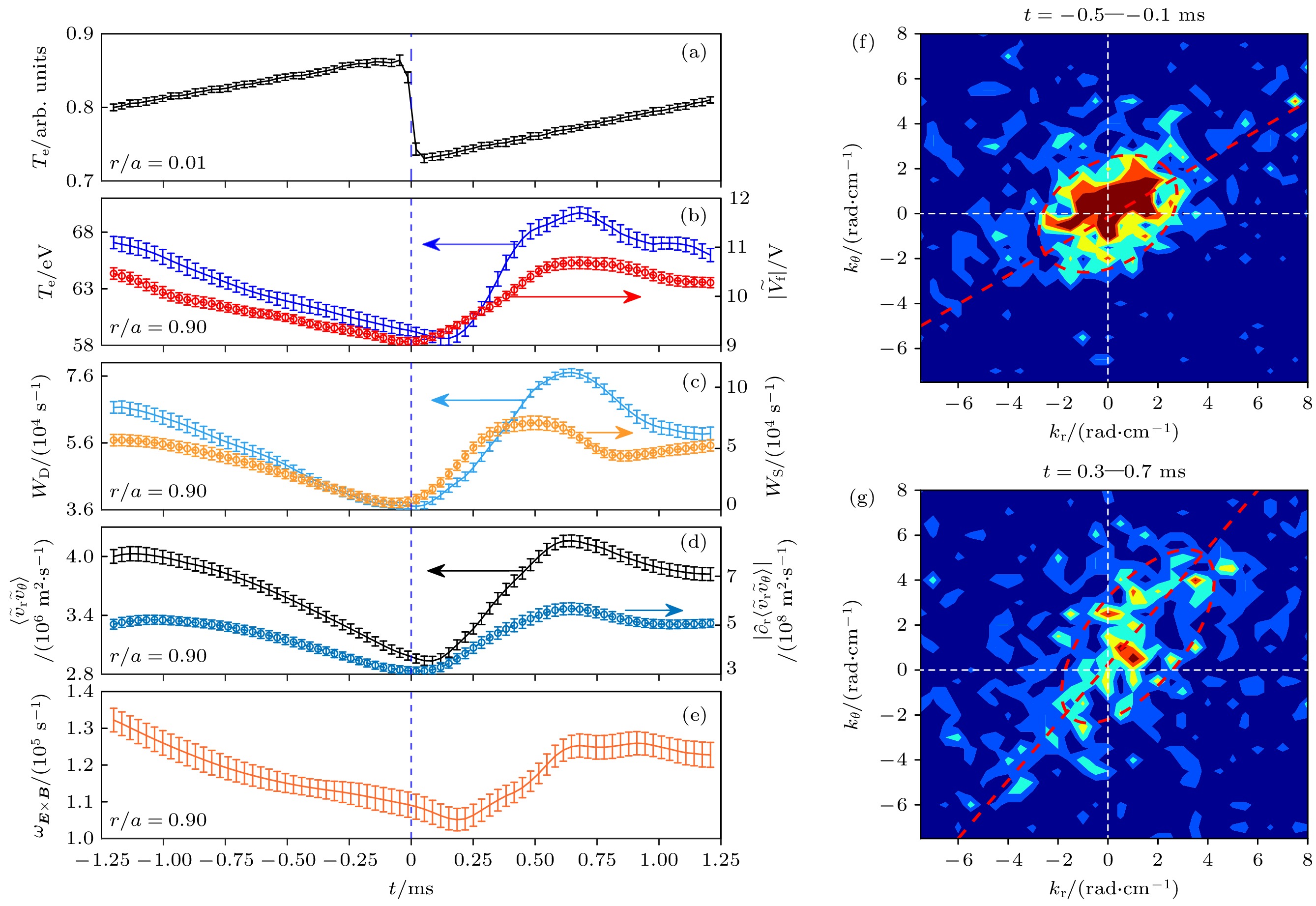
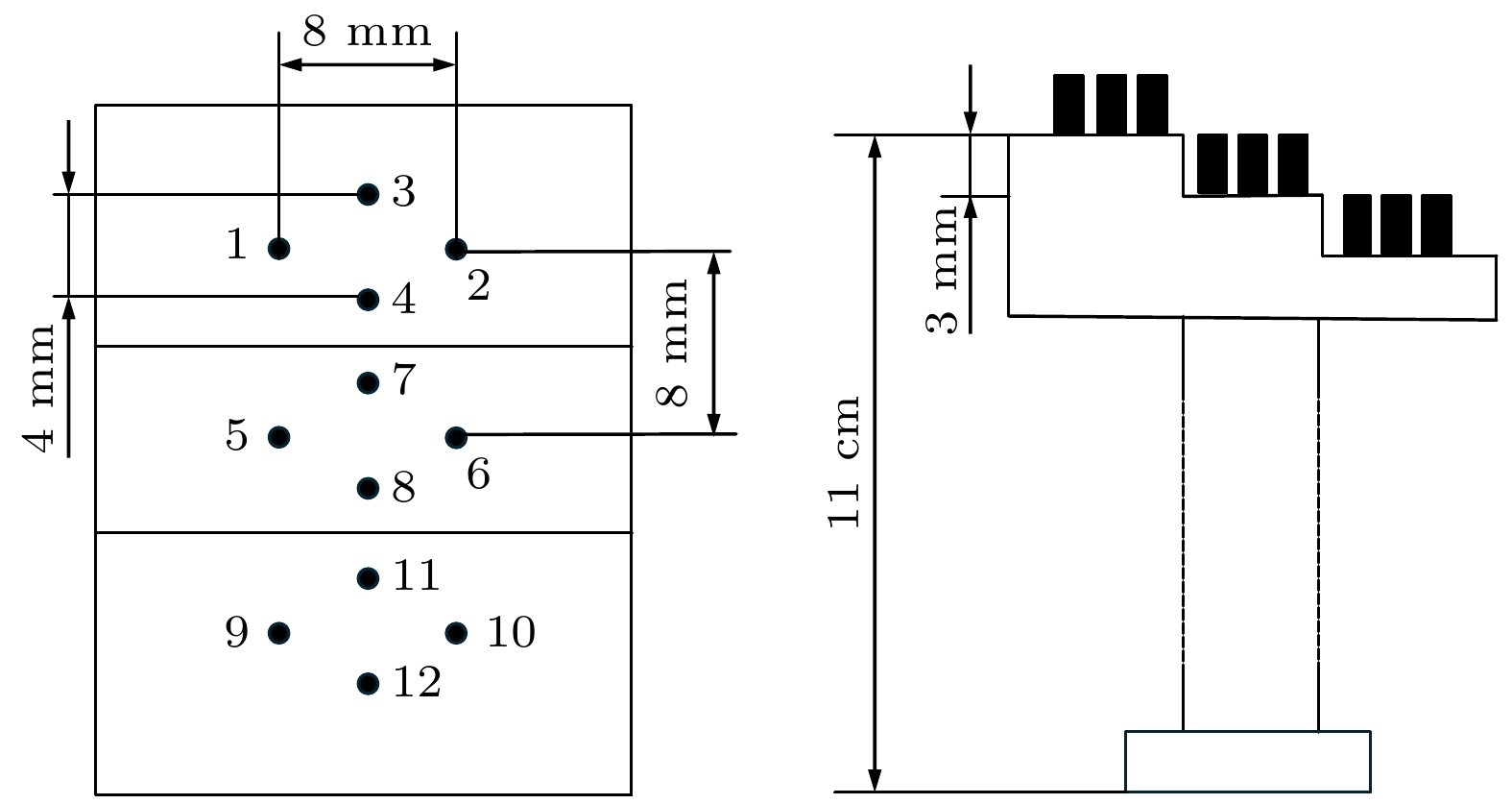
 下载:
下载:
